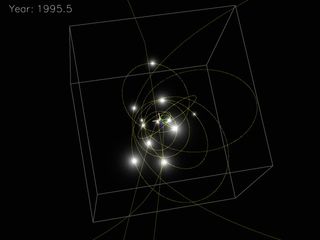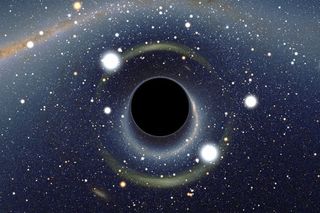Stars May Be Forming in Shadow of Milky Way's Monster Black Hole

Despite the harsh environment created by the monster black hole lurking in the center of the Milky Way galaxy, new observations show that stars — and, potentially, planets — are forming just two light-years away from the colossal giant.
Bright and massive stars were spotted circling the 4-million-solar-mass behemoth more than a decade ago, sparking a debate within the astronomy community. Did they migrate inward after they formed? Or did they somehow manage to form in their original positions?
Most astronomers had said the latter idea seemed far-fetched, given that the black hole wreaks havoc on its surroundings, often stretching any nearby gas into taffylike streamers before it has a chance to collapse into stars. But the new study details observations of low-mass stars forming within reach of the galactic center. The findings lend support to the argument that "adult" stars observed in this region formed near the black hole. [Images: Milky Way's Monster Black Hole Shreds Space Cloud]
The new evidence for ongoing star formation near the black hole is "a nail in the coffin" for the theory that the stars form in situ, said lead author Farhad Yusef-Zadeh, of Northwestern University. The observations, if accurate, make it unlikely that the stars migrated from elsewhere, the researchers said.
Birth near a black hole
Stars are born within clouds of dust and gas. Turbulence within these clouds give rise to knots that begin to collapse under their own weight. The knots grows hotter and denser, rapidly becoming protostars, which are so-named because they have yet to start fusing hydrogen into helium.
But a protostar can rarely be seen. It has yet to generate energy via nuclear fusion, and any faint light it does produce is often blocked by the disk of gas and dust still surrounding it.
So, when Yusef-Zadeh and his colleagues used the Very Large Array in New Mexico to scan the skies near the central supermassive black hole, they didn't spot the protostars but rather the disks of gas and dust surrounding them.
Get the Space.com Newsletter
Breaking space news, the latest updates on rocket launches, skywatching events and more!
"You could see these beautiful cometary-shaped structures," Yusef-Zadeh told Space.com. Intense starlight and stellar winds from previously discovered high-mass stars had shaped these disks into cometlike structures with bright heads and tails. Similar structures (called bow shocks) can be seen anywhere young stars are being born, including the famous Orion Nebula.

"There is, of course, one big catch here — and that is that the tidal force on the black hole is so strong that it's hard to see how these stars would form," Yusef-Zadeh said. "Many people think that star formation is forbidden near a supermassive black hole. But nature finds a way."
Astronomers have managed to find a way as well. Over the last decade, they've come up with two scenarios, both of which use the nearby black hole to simulate star formation.
In the first scenario, a cloud might break apart in the strong gravitational field and reassemble into a disk that surrounds the black hole. This disk would then form stars in the same way that the disks surrounding young stars form planets. Although this scenario was first proposed in 2005 by Sergei Nayakshin, an astronomer at the University of Leicester in the United Kingdom, it predicts the formation of low-mass stars. Until now, such stars hadn't been discovered in the galactic center.
In the second scenario, a cloud gets stretched into a taffylike streamer. But as this happens, the gravitational tide from the nearby black hole does two different things. "It disrupts in one direction, but it squeezes in another direction," Yusef-Zadeh said. It's this squeezing, or compressing, that would trigger star formation within the long streamer, Yusef-Zadeh added.
Both scenarios explain why stars encircling the monster black hole, called Sagittarius A*, are found in two rings, or disks, as opposed to random placements.
But some astronomers remain cautious.
"The center of our galaxy is a unique and extreme environment very different from our local solar neighborhood and the rest of the Milky Way," said Jessica Lu, an astronomer at the University of Hawaii's Institute for Astronomy. It's therefore crucial that astronomers don't jump to any conclusions.
"While these bow shocks have similar shapes to protostars seen in the nearby Orion cluster, there are other ways to produce these bow shocks around small clumps of gas," Lu told Space.com in an email. [The Strangest Black Holes in the Universe]
A place for planets
Some scientists who do think that stars — even low-mass stars — are forming within a few light-years of supermassive black holes are now starting to wonder if planets are forming there, too.
Typically, a disk circling a protostar will break up into clumps of gas and dust that later become full-fledged planets. But in such an extreme environment, the wind from nearby stars (the same winds that are responsible for the cometlike shapes of the disks seen by Yusef-Zadeh and his colleagues), may also steal mass from these disks. Yusef-Zadeh and his colleagues estimate that there could be enough material left in those disks to form planets.
The team plans to use the Atacama Large Millimeter/submillimeter Array (ALMA) in northern Chile to better probe the disks where the planets may form. ALMA's high sensitivity will reveal the disks' masses and maybe even any gaps in the disks, which likely result from forming planets.
"We're just beginning to really learn about this environment," Yusef-Zadeh said, adding that he's excited to start picking away at all of the questions the new study has opened.
The study will be published in an upcoming issue of The Astrophysical Journal Letters and is available online.
Follow Shannon Hall on Twitter @ShannonWHall. Follow us @Spacedotcom, Facebook and Google+. Original article on Space.com
Join our Space Forums to keep talking space on the latest missions, night sky and more! And if you have a news tip, correction or comment, let us know at: community@space.com.

Shannon Hall is an award-winning freelance science journalist, who specializes in writing about astronomy, geology and the environment. Her work has appeared in The New York Times, Scientific American, National Geographic, Nature, Quanta and elsewhere. A constant nomad, she has lived in a Buddhist temple in Thailand, slept under the stars in the Sahara and reported several stories aboard an icebreaker near the North Pole.
